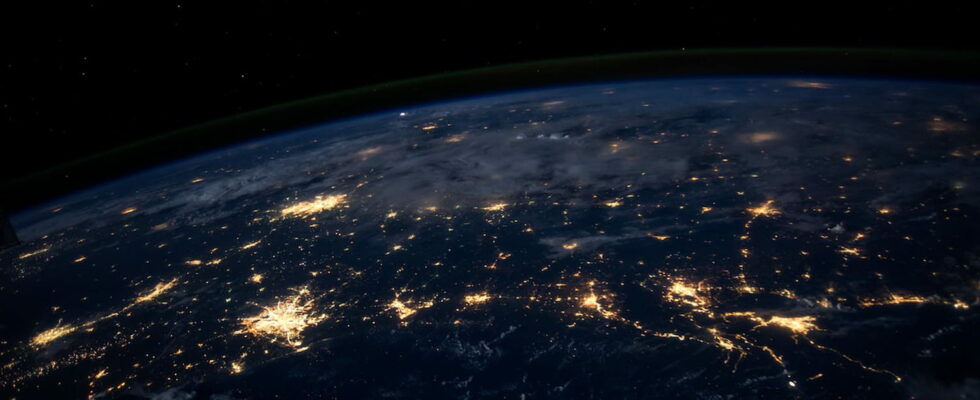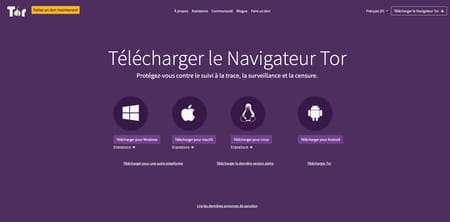Associated with all kinds of illegal activities, the Dark Web is the object of many fantasies in the imagination of Internet users. Here’s what you need to know about this hidden side of the Internet, which is both fascinating and disturbing.
Since the advent of the Internet, the Web has become an essential tool in our daily lives, and its importance is only growing. It has billions of pages, plus databases and servers that all run 24 hours a day. Yet we only browse a tiny part, called the “surface web.” Beneath this tip of the iceberg is a much larger and more complex area called the Deep Web, which is not indexed by search engines. This place itself has a hidden and clandestine side where everything is permitted: the Dark Web. A term which, in the imagination of many, designates a place full of illicit activities and trafficking of all kinds (sales of weapons, drugs, organs, human beings, spy tools and piracy, exchange of child pornography content, conspiratorial or terrorist activities, etc.). This is what sends shivers down your spine! But contrary to what one might think, it is not frequented only by people devoid of any morals and can be very useful… AT condition to take several precautions!
What is the Deep Web?
The Surface Web (or Web Surface) is the part of the Web most commonly used by Internet users. Anyone can access it through a web browser like Firefox, Google Chrome, Microsoft Edge or Safari. It consists of all the pages that are indexed on search engines like Google, Bing and Opera. Yet, even though it is the most well-known and commonly thought of part of the Web, it represents only a small portion of the Web. – it would be a bit like the emerged surface if we had to compare it to an iceberg.

Indeed, if you think about it, the vast majority of pages are not accessible by searching in a search engine, and yet here too they are used daily, without necessarily thinking about it. They constitute what is called the Deep Web, or Deep Web in French – it is also called the Invisible Web. These are websites and data that are protected by passwords, firewalls or encryption protocols, and not directly accessible to the general public. This is particularly the case for paid content, bank accounts, streaming accounts such as Netflix or Disney+, back offices or electronic messaging. Take the example of a bank. Its website includes a public part referenced in search engines and accessible to all (support page, home page, news, etc.) – which is part of the surface Web -, but also a private part which concerns all the banking information of its customers and which is accessed by entering its identifiers – which is therefore part of the Deep Web. The latter also includes database pages that are too large to be indexed and the internal networks of companies, governments or educational institutions used. In short, nothing to do with the illegal activities and the zone of lawlessness that one can therefore imagine, which in reality only correspond to a small part of the Deep Web.
Dark Net and Dark Web: what differences?
In this vast ocean is the Dark Net, a system of networks interconnected and parallel to the Web that we use on a daily basis – which is then called in contrast the “light” Web. The Dark Web can only be accessed through specific software, configurations or protocols, such as the Tor browser (The Onion Router) – which is the best known –, I2P and Freenet, which limits its access while guaranteeing a high degree of anonymity. We talk about overlay networks because each relies on another to function. For its part, Tor uses a relay system to hide the IP address of the user by passing the communication through several servers in different countries, which makes it difficult to locate the user and identify his real IP address, and therefore allows him to browse without leaving traces.
Within this set of hidden and private networks, there are sites accessible only via these anonymous networks and which form the famous Dark Web. The difference between the Dark Net and the Dark Web is subtle, and it’s easy to confuse the two. To simplify, we can say that the first designates the physical infrastructure, the network as such – the container in short –, while the second concerns the content found there. The term Dark Web is often used to designate a criminal Web, evolving outside of any legal framework and where one can do all kinds of illegal activities and businesses, such as the sale of firearms, the trade of data private hacks, drug trafficking, pedophilia networks or even sexual exploitation parlors. However, not all activities are illegal! Indeed, the Dark Web also hosts encrypted sites that allow journalists, activists or political opponents to communicate and share information without fear of government surveillance and escaping censorship in some countries.
The Dark Web uses routing software and anonymous servers to allow anonymous browsing. It is therefore necessary, as we have seen, to go through specific tools such as Tor. The latter encrypts and redirects the user’s request through several layers of servers, called nodes, around the world. These nodes are computers that act as relays for Internet traffic, redirecting it through the network. Each of them can only see the IP address of the previous node and the next node, which makes tracing the user very difficult – but not impossible. Once the request reaches the last node in the network, it is sent back to the user’s browser, which can then access the desired site. The disadvantage of this system is that the connection is much less fluid and fast than on the “Surface Web”.
The addresses of the sites are different from those of the traditional Web. These are called onion URLs (onion, in English) because they often end with “.onion” instead of “.com”, “.fr” or “.org”. This are unique identifiers generated by the Tor network, which consist of a series of random letters and numbers, making them very difficult to find and remember.
First of all, remember that, While it is not illegal to surf the Dark Web, participating in activities punishable by law obviously is. It should also be kept in mind that this part of the web is very dangerous, and that users can find themselves exposed to malware and scams, but also to surveillance by police and government services. With all these necessary reminders in mind, theThe first thing to do is to use a real VPN for conceal its true IP address and securely encrypt its Internet connection. It is also essential toinstall a good antivirus and anti-malware on your computer because of the many malwares that are rampant on the Dark Web. Then you have to download and install special software like Tor, the latter being available on Windows, Mac, Linux, iOS and Android. Once this is done, it is then possible to access Dark Web sites by entering their specific .onion address.
Since they are not indexed by ordinary search engines, Dark Web addresses cannot be found by a traditional search with engines like Google or Bing. To find them, there are several methods. The first is to look in directories, like The Hidden Wiki or the DarkWebLinks site. They are accessible via search engines, but beware, not all links are safe! Some Dark Web users share onion URLs on social media, like Twitter or Reddit, but again the links aren’t always safe. Finally, and this is certainly the safest method, some users can share addresses directly with each other, through personal recommendations. Again, please note that due to navigation through the knots, dark web sites are slower than regular sites. You have been warned!

